
The Orchidaceae are a diverse and widespread family of flowering plants, with blooms that are often colourful and fragrant, commonly known as the orchid family.

Cypripedioideae is a subfamily of orchids commonly known as lady's slipper orchids, lady slipper orchids or slipper orchids. Cypripedioideae includes the genera Cypripedium, Mexipedium, Paphiopedilum, Phragmipedium and Selenipedium. They are characterised by the slipper-shaped pouches of the flowers – the pouch traps insects so they are forced to climb up past the staminode, behind which they collect or deposit pollinia, thus fertilizing the flower. There are approximately 165 species in the subfamily.

Zygopetalum is a genus of the orchid family (Orchidaceae), consisting of fourteen currently recognized species.
The taxonomy of the Orchidaceae has evolved slowly during the last 250 years, starting with Carl Linnaeus who in 1753 recognized eight genera. De Jussieu recognized the Orchidaceae as a separate family in his Genera Plantarum in 1789. Olof Swartz recognized 25 genera in 1800. Louis Claude Richard provided us in 1817 with the descriptive terminology of the orchids.. The next step was taken in 1830-1840 by John Lindley, who recognized four subfamilies. He is generally recognized as the father of orchid taxonomy. The next important step was taken by George Bentham with a new classification, recognizing subtribes for the first time. This classification was first presented in a paper that Bentham read to the Royal Society in 1881. Then it was published in 1883 in the final volume of Genera Plantarum. The next great contributors were Pfitzer (1887), Schlechter (1926), Mansfeld (1937), Dressler and Dodson (1960), Garay, Vermeulen (1966), again Dressler (1981). and Burns-Balogh and Funk (1986). Dressler's 1993 book had considerable influence on later work.
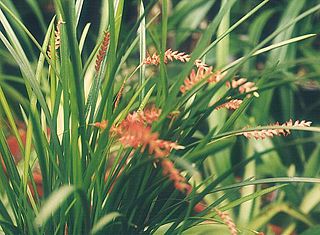
Dendrochilum is a genus of epiphytic, lithophytic and a few terrestrial flowering plants in the orchid family (Orchidaceae). The name of this genus is derived from Ancient Greek words dendron ("tree"), and either cheilos ("lip") or chilos, alluding to either the flowers' large lip or to their epiphytic growth. These orchids are popular among fans of non-traditional orchid curiosities.

Stenia is a genus in the orchid family (Orchidaceae). It was established by John Lindley in 1837. These epiphytic plants occur in warm, humid habitats of Trinidad and the Amazonian slope of the northern Andean region in South America.

Disperis is a genus of plants in the orchid family, Orchidaceae. It has about 78 species. Most of the species are from tropical and southern Africa, as well as Indian Ocean islands. A few are native to the tropical or the warmer subtropical regions of Asia and Malesia.

Dendrophylax is a genus of leafless neotropical orchids native to Mexico, Central America, the West Indies, and Florida. The name is from Greek δένδρον ("tree") and φύλαξ. One species, Dendrophylax lindenii, featured heavily in the book The Orchid Thief.
Coilochilus is a genus of flowering plants in the orchid family, Orchidaceae. It contains only one known species, Coilochilus neocaledonicum, endemic to New Caledonia. Its closest relative is Cryptostylis, sole other genus of subtribe Cryptostylidinae.
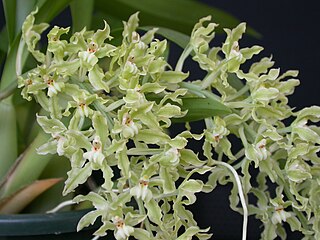
Gomesa is a genus of flowering plants from the orchid family, Orchidaceae. It contains about 80–100 species, all native to South America.

Warrea is a genus of flowering plants from the orchid family, Orchidaceae. It has three known species, all native to Latin America.
Hederorkis is a genus of flowering plants from the orchid family, Orchidaceae. It contains two known species, both native to islands in the Indian Ocean.
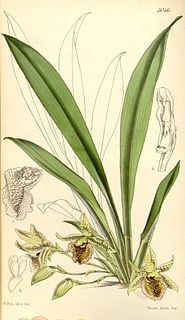
Kefersteinia is a genus of flowering plants from the orchid family, Orchidaceae. It has about 40-50 species, widespread across much of Latin America. The genus was named for Keferstein of Kröllwitz, an orchidologist.

Diseae is an orchid tribe in the subfamily Orchidoideae. It was recognized in Genera Orchidacearum volume 2, which was published in 2001. It consisted of 12 genera in five subtribes. In molecular phylogenetic studies that were published after 1999, it was shown that Diseae is paraphyletic over the tribe Orchideae. In a classification of orchids that was published in 2015, Diseae was not recognized, but was instead placed in synonymy under Orchideae.

Coryciinae is a subtribe of orchids that has been differently defined and placed in the two classification systems that are currently in use for orchids. Genera Orchidacearum, which is currently the definitive work on orchid taxonomy, delimits Coryciinae as consisting of five genera: Disperis, Evotella, Ceratandra, Pterygodium, and Corycium, and it places Coryciinae in the mostly African tribe Diseae, along with four other subtribes: Brownleeinae, Huttonaeinae, Disinae, and Satyriinae. The genera of Coryciinae are small to medium in size and the number of species in each genus is as follows: Disperis (78), Pterygodium (19), Corycium (15), Ceratandra (6), and Evotella (1).

Maxillariinae is an orchid subtribe in the tribe Cymbidieae. It was formerly treated as the tribe Maxillarieae, and divided into a number of subtribes.
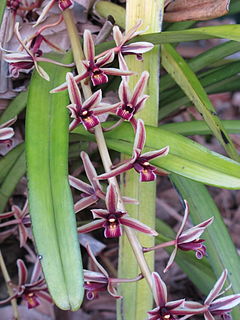
Cymbidiinae is an orchid subtribe in the tribe Cymbidieae.
Stenotyla is a genus of orchids. It contains 9 known species, all native to Central America and southern Mexico.
- Stenotyla estrellensis(Ames) P.A.Harding - Costa Rica
- Stenotyla francoiArchila - Guatemala
- Stenotyla helleri(Fowlie) P.A.Harding - Nicaragua
- Stenotyla lankesteriana(Pupulin) Dressler - Costa Rica, Panama
- Stenotyla lendyana(Rchb.f.) Dressler - Oaxaca, Chiapas, Guatemala, El Salvador, Honduras
- Stenotyla maculataArchila - Guatemala
- Stenotyla maxillapertaArchila - Guatemala
- Stenotyla panamensisPupulin - Panama
- Stenotyla picta(Rchb.f.) Dressler - Costa Rica, Panama
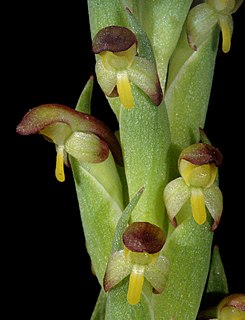
Disinae is a subtribe of orchids that has been differently defined and placed in the two classification systems that are currently in use for orchids. Genera Orchidacearum, which is currently the definitive work on orchid taxonomy, delimits Disinae as consisting of two closely related genera, Disa and Schizodium, and it places Disinae in the mostly African tribe Diseae, along with four other subtribes: Brownleeinae, Huttonaeinae, Coryciinae, and Satyriinae. In the classification for orchids that was published by Chase et alii in 2015, Schizodium was placed in synonymy under Disa, while Pachites and Huttonaea were transferred to Disinae. In Genera Orchidacearum, Pachites and Satyrium form the subtribe Satyriinae, and Huttonaea is the sole genus in the subtribe Huttonaeinae. The transfer of Pachites and Huttonaea to Disinae by Chase et alii (2015) was done with considerable doubt, and was based upon uncertainty about the relationships of these two genera. In 2009, a molecular phylogenetic study found only weak statistical support for a sister relationship between Huttonaea and Disa.















